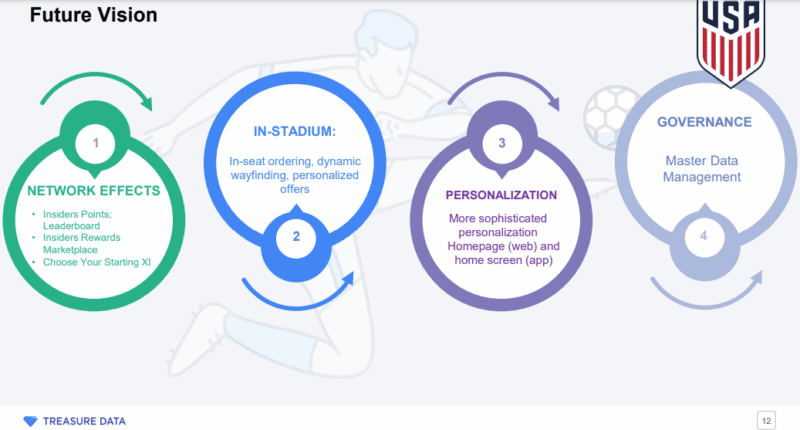Ross Moses, Senior Director of Analytics and Insights at the United States Soccer Federation, saw a need to re-evaluate how the organization interacted with its customer base. Despite the vast amount of digital resources available, he found it was failing to offer fans engaging experiences.
“We were sitting on an outdated digital infrastructure — there wasn’t much there,” Moses said in his presentation at our MarTech conference. “We had an outdated website, no mobile app, and a lot of manual tasks that we were using to track our customers. So, we knew that we had to invest heavily in this space.”
Getting your brand’s digital infrastructure in place is important, but it’s nothing without establishing strong customer connections. To do so, U.S. Soccer needed strategies and tools to better identify its customers — who they were and where they were coming from.
“The next challenge was identifying our fans, getting the 360-degree view of the customer,” Moses said. “This tends to be the Holy Grail, not just for us, but for a lot of businesses out there. Putting that in place would allow us to have that business intelligence to have more efficient feedback loops, and then enable personalization.”
Moses and his marketing team worked with customer data platform Treasure Data to develop a robust customer experience strategy. Here are some of the insights they gained in the process.
Use automation to personalize experiences
Moses highlighted U.S. Soccer’s loyalty program, which rewarded customers based on their interactions with the program. Using a CDP framework, The organization was able to personalize each customer’s experience with automated messaging that fit their group.

“This is our loyalty program known as U.S. Soccer Insiders,” said Moses. “Based upon the tier that you’re in, from the standard tier up to VIP, you’re getting a different message.”
He added, “This illustrates how once you have that segment created in a CDP, you’re sending it somewhere else. And then you’re using those audiences to program step-by-step journeys.”
Brands should remember that CDPs aren’t designed to fit within every organization’s framework — some aren’t going to meet your automation or personalization needs exactly. However, many allow users to develop custom solutions.
“There are a lot of pre-built connectors [in CDPs],” he said. “But if there’s something that not off-the-shelf, you can develop on top of it. So, if there’s some obscure data source, you can build those pipelines so that it comes in a batch or stream.”

Looking to take control of your data? Learn about trends and capabilities of customer data platforms in the latest edition of this MarTech Intelligence Report.
Gather relevant business intelligence
Moses and his team extracted the relevant customer information from all of their platforms using a CDP, pulling in relevant information such as average annual spending, renewals, etc. They used this data to make better business decisions when choosing U.S. Soccer’s match locations.

“There’s a lot that goes into picking where we take the team,” he said. “It’s not all based upon where the customers are. There’s a lot of other factors, like the opposing team, or how long it’s been since we’ve been there.”
He added, “This information helps us understand where customers are coming from and where we think there might be an opportunity.”
Pulling in this valuable business intelligence from many customer sources is critical for brands wanting to develop a sustainable customer experience strategy.
Develop a future vision
Using the insights gathered from its audience, U.S. Soccer made a new game plan for delivering enhanced customer experiences. Knowing what fans wanted out of its digital assets, the organization developed new ways of connecting with them.

One of the more popular upgrades allowed customers to predict the starting 11 players, which also extended to other aspects of the game.
“Soccer fans love to debate who should be in the starting lineup, or who should even be called into the roster for a specific game,” Moses said. “This is a way to build some community and discussion around this topic. Within the app, we allow people to easily create ana field map and then share it on social, continuing the conversation.”
He added, “A lot of the personalization we’re doing is in advertising or email marketing, but we need to bring this into our inbound experiences.”
Gaining a full view of customers and extracting insights from their journeys serve as foundations for future strategies. But to be sustainable, marketers must practice proper data governance to keep everything in line. This is where CDPs often work well with data management platforms (DMPs), informing the latter to create more relevant audience experiences.
“Our CDP is our master data
MarTech
, but we need to do more in terms of bringing in those other data sources and getting that holistic view,” Moses said. “We need to make sure that we have that data mastered so that we have the utmost confidence in our analytics and personalization.”
Source link



